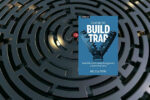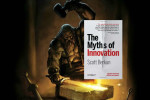Borrowing, Forgetting and Learning

To successfully incubate and spin-off new ventures, companies must use the right mix of borrowing, forgetting, and learning organizational DNA.
Ten Rules for Strategic Innovators: From Idea to Execution by Vijay Govindarajan
Ten Rules for Strategic Innovators covers strategic innovation, which he defines as a process of exploring experimental strategies. He focuses specifically on what it takes to incubate and spin off a successful new business (NewCo) from within an established one (CoreCo). Successfully creating a new venture from within an existing company requires the right mix of borrowing DNA (assets, culture, processes), forgetting current ways of doing work, and learning about new markets, customers, and competitors. Taking too much of the current context forward (borrowing) and not leaving enough behind (forgetting) are recipes for failure. In its new environment, NewCo must establish processes for learning and adjusting quickly as NewCo’s mission is primarily one of discovery.
Strategic Innovation
Strategic innovation involves testing new, unproven and significantly different answers to at least one of the fundamental questions of strategy: who is your customer? What is the value you offer to the customer? How do you deliver that value?
Strategic innovation is a specific growth strategy that emphasizes testing viability of new business models.
Strategic experiments are characterized by high potential for revenue growth, focus on emerging or yet-to-be-defined industries, target a radical break from the existing business, and use some existing capabilities and assets. Although there is the promise of great rewards, the risk is very high and financial performance is initially unclear and potentially very poor.
Strategic innovation is not the same as other common growth strategies: continuous process improvement, process revolution, and product or service innovations. Although it may contain aspects of these innovation types, strategic innovation always involves an unproven business model. A business should engage all four types of innovation since each has a different time horizon, risk profile, and investment requirements.
How to fail at strategic innovation
The biggest mistake a CEO can make when initiating a strategic innovation initiative is to assume that execution will take care of itself and walk away once the project has been initiated. Identifying a winning idea and a stellar leader is only the first step. However, the CEO must guide the new venture in acquiring funding, learning quickly, rallying people around a hazy future vision, and manage expectations in a chaotic environment.
Given the challenges in separating from CoreCo, the CEO must protect and support the NewCo team who, in turn, must follow the Intrapreneur’s Ten Commandments. Govindarajan says that even this is not enough–the team must “alter organizational codes to accelerate innovation.”
The Mystery of the Middle
The value of strategy (the value of the innovative idea) is limited, simply because it is speculative and uncertain. … It is not the idea that counts; it is what you do with it.
Govindarajan presents two organizational codes: efficiency (Code A) and creativity (Code B). Code A encourages optimization. Code B is thinking outside the box. To move from creativity to profitability requires Code X–the right mix of borrowing, forgetting, and learning. This theme is common in business literature. What Govindarajan calls Code X, Roger Martin calls design thinking (the blend of analytic and creative perspectives).
Forgetting
NewCo must forget CoreCo’s business definition (customers, value proposition, delivery mechanism). NewCo must also invent its own business model, leaving behind the model that made CoreCo successful. Additionally, NewCo needs to focus on exploration (finding new sources of value) rather than exploitation (extracting value from the current business environment).
Learning
The best indication that learning is taking place is that predictions improve
The most important metric for NewCo is its ability predict its own business performance. As predictions improve, NewCo becomes better able to find its new business model.
The right organizational design for NewCo
Neither replication nor isolation works. Replication facilitates borrowing, but not forgetting or learning. Isolation may allow forgetting and learning, but not borrowing.
Strategic experimentation (NewCo) has strong needs for both borrowing and forgetting. Govindarajan distinguishes strategic experimentation from new businesses which are completely unrelated to CoreCo and innovations within existing business models. In the former case, there is a low need for borrowing and a high need for forgetting. In the latter, borrowing is high and forgetting is low. The right design consists of linking NewCo and CoreCo in a few high leverage areas with strong support from the executive team in maintaining the links. This encourages borrowing in areas which will propel NewCo forward, but forgetting those aspects of CoreCo DNA which will weigh down NewCo by chaining it to existing business model elements.
With a supportive executive team and targeted NewCo support, CoreCo can forge its own path to the future, balancing independence with lessons learned in the existing business. Focus on learning will help NewCo successfully navigate its way to finding the right business model for the new venture.







